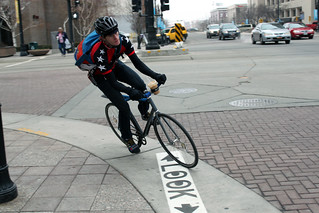For the second time since the League of American Bicyclists began ranking U.S. states’ bike-friendliness in 2008, Oregon didn’t make the top five.
As it has in every year, Washington led the 2015 ranking that the League announced on Monday. Washington was followed this year by Minnesota, Delaware, Massachusetts and Utah, then Oregon at sixth.
Though Oregon’s slip from third in 2013 (its all-time peak) to fifth last year to sixth this year certainly has echoes of the recent #DowngradePortland campaign launched by local bike advocates in an effort to persuade the League to rescind Portland’s “platinum” rating as a bike city, this statewide ranking is different. It’s also a ranking rather than a rating system, based on a 100-point scale that the League bases on a national questionnaire.
Washington earned 66.2 points on the League’s scale in 2015 based on the strength of its legislation, enforcement practices, policies, infrastructure, funding, education, encouragement, evaluation and planning. Oregon earned 54.2 points.
Alabama, which once again ranked last in the country, got 12.3 points.
The most useful thing in the ranking over the years (PDF) is seeing states that have dramatically improved their ratings. Most notable on that list might be Utah (31st in 2011, 4th today) but there are other risers like Ohio (37th in 2011, 16th today) and states on consistent slides such as Wisconsin (3rd in 2011, 9th today).
Advertisement
Meanwhile, the League has provided a list of customized advice for Oregon’s legislature, Department of Transportation and other bodies to improve our ranking:
• Repeal the state’s mandatory bike lane law. These types of laws ignore the quality and safety of available bike lanes.
• Adopt performance measures, such as mode shift or a low percentage of exempted projects, to better track and support Complete Streets/Bike Accommodation Policy compliance.
• Publicly disclose compliance with Oregon’s landmark Bicycle Bill, ORS 366.514, on every highway, road or street being constructed, reconstructed or relocated.
• Update your state bicycle master plan. The plan update should evaluate and build on the previous bicycle master plan, and reflect changes in bicycle user needs.
• Adopt a comprehensive Vision Zero policy to help Oregon reduce crashes, injuries, and fatalities.
• Increase the amount of state funding dedicated to bicycle and pedestrian projects from 1% of state transportation trust funds to at least 2%.
• Adopt a mode share goal for biking to encourage the integration of bicycle transportation needs into all transportation and land use policy and project decisions.
• Officially endorse the NACTO Urban Streets and Bikeway Design Guide, incorporate its designs into state engineering and design manuals, and encourage its use on the state highway network in urban areas, including collector and arterial roadways.
• Adopt performance measures to decrease bicycle fatalities.
• Consider ways to promote strategic sidewalk and bikeway infill priorities through planning activities grant programs, or funding programs.
Last time Oregon landed outside the League’s top five, in 2011, the Oregon Department of Transportation protested the ranking’s methodology. It’ll be interesting to see whether this ranking draws any formal reply.
It’s worth noting that Oregon still has the most bike commuters of any state, 2.4 percent, by a fairly wide margin. After Oregon, the states with the most bike commuting are Montana (1.5 percent) and Idaho (1.4 percent).
You can learn more about the League’s state rankings here.



